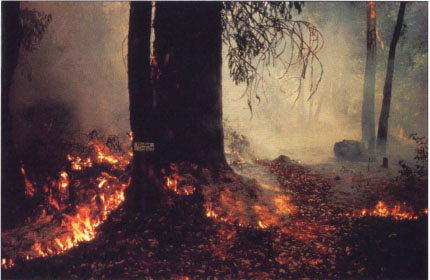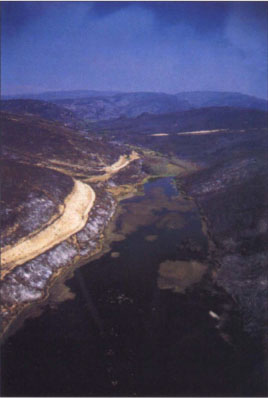All Issues
Fighting fire with fire science
Publication Information
California Agriculture 53(3):8-10.
Published May 01, 1999
PDF | Citation | Permissions
Full text
Fire is a constant challenge for the state's natural resource managers. For most of this century, fire suppression has been the rule at the state and federal levels. Each year, the California Department of Forestry puts out, on average, 7,500 fires; federal agencies suppress another 2,000, according to the California Forest Stewardship Program's recent newsletter. The result has been dramatically denser vegetation and greater risk of catastrophic wildfire.
Fire scientists generally concur that prescribed burning is one way of reducing this risk, in part by clearing land of dense undergrowth. But there is some potential conflict between agricultural and forest materials burning, primarily because of restrictions under the California Air Resources Board — which is now in the process of revising, and likely restricting, its agricultural and forest burning rules. At times, the complexity and controversy of fire management in California seem as ubiquitous as fire itself.
UC researchers are working to address these issues and provide scientific analysis for sound policy decisions.
UC Davis researchers David Rizzo ( see page 17 ), Michael Barbour, Tom Cahill, John Reuter and others recently participated in a special watershed assessment of the Lake Tahoe Basin for the U.S. Forest Service. Part of the study deals with reconstruction of past fire regimes and predicting the effects of prescribed burns on air and water quality in the region, where fire suppression policies have prevailed for 75 years.
To determine which ecological factors have most affected the watershed, the researchers drew from the work of Richard Minnich, a UC Riverside geographer and leading fire-ecology researcher who has been studying wildfires and their effects in chaparral and forest vegetation of the Sierra San Pedro Martir of Baja California. This landscape is ecologically similar to that of the Tahoe Basin but has no history of fire suppression. Minnich concludes that major under-story wildfires still occur in Sierra San Pedro Martir two or three times each century.
By comparing vegetation in the Tahoe Basin with that at the Mexico site, the Davis team determined that fire suppression has affected the Basin's ecosystem more than any other single factor. And other work by these researchers suggests these effects are not beneficial.
As reported in 1995 and 1999 publications, and through their latest work in the Tahoe Basin, the scientists found that some herb, shrub and tree species reproduce, regenerate and grow better in the absence of periodic ground fires than in their presence. The plants' abundance changes the suitability of the forest for wildlife: for example, bird biodiversity declines, and the incidence of disease and mortality among trees of all ages increase significantly. These findings suggest that the absence of periodic fires is good for some species and bad for others — with dramatic implications for overall landscape and habitat.
The researchers acknowledge that prescribed burns can reduce the risk of catastrophic fire but have risks of their own, including emissions of gases and particulates that can travel long distances with implications for human health, air and water quality and visibility. A final report of the Tahoe Basin study should be issued in June.
Kurt Menning, a Rosecranz and Abraham Scholar at UC Berkeley, studies how reintroduction of fire through prescribed burning may restore mixed-conifer forests in Sequoia National Park. He is analyzing the consequences for wildlife habitat, forest structure and forest composition by collecting data from three time periods (historic, current and postfire) and at two spatial scales (within forest stands and across landscapes). The data is collected on 200 circular research plots and from an airplane using digital multispectral photography. “When data from several spatial scales are combined and the transitions between the time period are analyzed,” Menning says, “we should have a better understanding of the ways in which prescribed fire can be used as a restoration tool.”
Other researchers are studying fire effects not in forests but in oak woodlands. While prescribed burning is used often to manage vegetation in these landscapes, little is known about how it affects wildlife populations. UC natural resources specialist William Tietje is leading a major, long-term study of how prescribed burns affect wildlife habitat at Camp Roberts, a military training site in San Luis Obispo County.
Tietje monitored populations of terrestrial vertebrates (small mammals, birds, reptiles and amphibians) in relatively undisturbed mixed blue oak-coast live oak woodlands for 4 years before, and 2 years following a 500-acre experimental prescribed burn. Initial responses from terrestrial vertebrates suggest their relative abundance has been largely unaffected by the low-intensity prescribed fire. In addition, more than half of the oak saplings he tagged survived the fire, and most of those killed by the fire subsequently resprouted. A more intense prescribed burn will be applied on the site later this year.
Another study is being led by Bill Frost, natural resources advisor for El Dorado, Amador and Calaveras counties and Neil McDougald, advisor for Madera and Fresno counties. The researchers are monitoring vegetation response on oak woodlands on the Ellis Ranch in Madera County. They inventoried the woodland before burn preparation work, after preparation, immediately after the fire and in subsequent years. Their findings suggest the fire has had little impact on oaks or associated woody vegetation in areas of low oak density, but that canopy cover decreased in areas of denser canopy (> 50%). Plots dominated by interior live oak were most affected by the burn, with less impact on sites dominated by blue or valley oak. Overall, canopy cover on the site has increased in the years since the burn. The researchers will conduct another inventory this fall.
Scientists are studying how to prevent wildfires like this catastrophic blaze at Big Creek Reserve in 1985.
Several UC programs are addressing fire risk and management at the wildland-urban interface, sometimes called the “I-Zone.” Long at the forefront in this area is the UC Forest Products Laboratory in Richmond. In one of its latest initiatives, the lab has implemented the Professional Fire Safe Inspector program, which trains personnel for development of fire safe plans for communities. The program is limited to six counties in Southern California, but will later be expanded. A second course under development will train those who will evaluate the fire safe plans for compliance with codes and regulations. A third course, yet to be developed, will focus on fire safe structural inspection. Program leaders also will produce a series of manuals on wildland fire prevention and mitigation at the I-Zone. Ultimately, the Forest Products Laboratory will be the clearinghouse for the California Department of Forestry and Office of the State Fire Marshal for information on fire in the I-Zone, according to lab director Frank Beall.
In another project, Michael Hamilton, director of the UC Natural Reserve System James San Jacinto Mountains Reserve, is applying advanced computing technologies for ecological assessment and wildfire hazard monitoring. He is leading a highly sophisticated and interactive Internet project to implement forest stewardship and fire hazard reduction practices in the Riverside County mountain community of Idyllwild, site of a devastating fire in 1996, and neighboring communities.
Fire is a constant in the California landscape. Shown above, an area of Point Reyes National Seashore after the fire of October 1995.
Funded with a 3-year grant from UC, California Department of Forestry, Apple Computer and the Federal Emergency Management Agency, the Mountain Communities Firesafe Project has evolved from painstaking research and ecological data gathered from some 6,000 properties over 12 years. The data were compiled using ground-based video images, airborne and satellite images and dozens of unique cartographic models developed through geographic information systems software.
The Mountain Communities Firesafe Project lets property owners evaluate current fire hazards, such as buildup of highly flammable chaparral, and test the performance of particular fire prevention measures in a digital “virtual forest,” without actually having to alter their land. Data from this project will also give fire prevention officials and land managers a powerful tool for enhanced ecosystem management. Those with Internet access can visit the Firesafe Project and view some of its “virtual forests,” by going to its website: www.tahquitz.org .
Some UC researchers are addressing the social and cultural aspects of fire management. UC Davis education specialist Joan Wright, UC Berkeley rangeland ecologist Lynn Huntsinger and retired UC Davis wildlands specialist Theodore E. Adams Jr. have produced a booklet and video titled How Can We Live With Wildland Fire? Meant as a community discussion guide, it helps communities decide how to address fire hazard by posing three policy approaches for discussion and highlighting the pros and cons of each. The guide has been used throughout California and Nevada and is available from UC's California Communities Program. The team also conducted interviews with elected officials, homeowners, firefighters and others in San Bernardino, Malibu, Quincy, Tahoe, Oakland and Marin and wrote summaries of local perceptions of fire hazard and how local issues influence community response. These write-ups are also available.
On the Berkeley campus, graduate students have established the Wildland Fire Research Group to foster and promote UC Berkeley research on fire management issues. The group will host a seminar series this fall. For information contact Tracy Benning (510) 643-2226; tbenning@nature.berkeley.edu.






